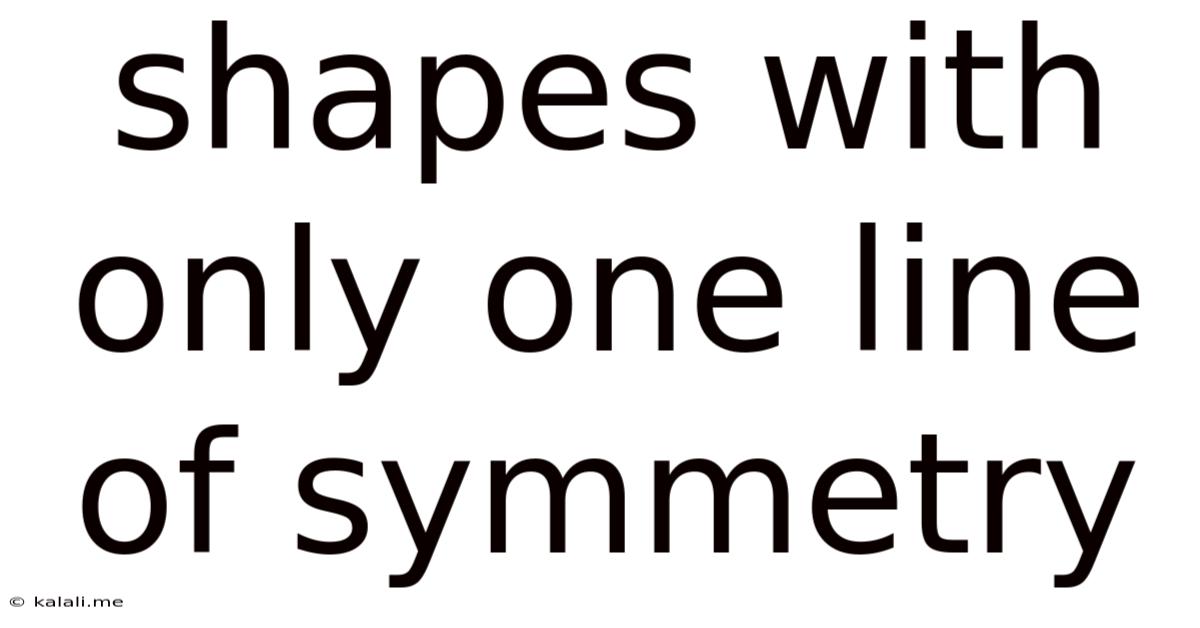Shapes With Only One Line Of Symmetry
Kalali
Jun 11, 2025 · 3 min read

Table of Contents
Shapes with Only One Line of Symmetry: A Deep Dive
This article explores the fascinating world of shapes possessing just a single line of symmetry. We'll delve into the definition of line symmetry, examine examples of such shapes, and discuss how to identify them. Understanding line symmetry is crucial in various fields, from art and design to mathematics and engineering. This guide will enhance your understanding of geometrical concepts and aid in identifying these unique shapes.
What is Line Symmetry?
Line symmetry, also known as reflectional symmetry, occurs when a shape can be folded along a line, creating two perfectly matching halves. This line is called the line of symmetry or axis of symmetry. The halves are mirror images of each other. Shapes can have multiple lines of symmetry, or, as we'll focus on here, just one.
Identifying Shapes with a Single Line of Symmetry
Many common shapes boast more than one line of symmetry (like a square or circle), but several shapes possess only a single axis of reflection. Let's explore some examples:
Examples of Shapes with One Line of Symmetry
-
Isosceles Triangles: An isosceles triangle has two sides of equal length. The line of symmetry runs from the vertex angle (the angle between the two equal sides) to the midpoint of the opposite side (the base). This line perfectly bisects both the angle and the base.
-
Scalene Triangles (with one line of symmetry): While most scalene triangles (triangles with all sides of different lengths) lack any lines of symmetry, a specially constructed scalene triangle can possess one line of symmetry. Imagine a scalene triangle where one side is perfectly vertical and the other two are mirror images across that vertical line.
-
Certain Quadrilaterals: Some quadrilaterals (four-sided shapes) can have only one line of symmetry. Consider a kite shape where two pairs of adjacent sides are equal in length, but the opposite sides are not equal. The line of symmetry runs through the intersection of the diagonals. A rhombus also has this characteristic if its angles aren't all 90 degrees.
-
Irregular Polygons: Irregular polygons, with sides and angles of varying lengths, can sometimes exhibit a single line of symmetry. This typically happens when a pattern of mirroring exists across a specific line. This requires careful construction and isn't as commonly observed as the other examples above.
-
Freeform Shapes: Even freehand drawings or naturally occurring shapes can occasionally possess a single line of symmetry. Think of a stylized leaf or a uniquely shaped droplet of water. The line of symmetry would be apparent upon visual inspection, showcasing a perfect reflection across this central line.
Applications of Shapes with One Line of Symmetry
Understanding shapes with a single line of symmetry has applications in diverse fields:
-
Art and Design: Artists and designers use this concept to create visually appealing and balanced compositions. The single line of symmetry can create a sense of focus and direction in a design.
-
Architecture: Buildings and structures often incorporate single lines of symmetry to create a sense of harmony and balance.
-
Nature: Many natural forms, such as leaves and certain insects, exhibit single lines of symmetry, highlighting nature's aesthetic principles.
Conclusion
Shapes with only one line of symmetry demonstrate the elegance and complexity found within seemingly simple geometric forms. By understanding the concept of line symmetry and exploring examples, you gain a deeper appreciation for the mathematical principles underlying visual aesthetics and design. Remember to consider the unique characteristics of each shape to accurately identify its lines of symmetry, or lack thereof. The exploration doesn't end here; further investigation into more complex shapes and their symmetry properties can prove highly rewarding.
Latest Posts
Latest Posts
-
How Many Apples In A 3 Pound Bag
Jul 01, 2025
-
How Many Pounds Is A Bushel Of Peanuts
Jul 01, 2025
-
How Many Pounds Are In 32 Ounces
Jul 01, 2025
-
What Year Would I Be Born If I Was 21
Jul 01, 2025
-
How Many Minutes Are In 40 Hours
Jul 01, 2025
Related Post
Thank you for visiting our website which covers about Shapes With Only One Line Of Symmetry . We hope the information provided has been useful to you. Feel free to contact us if you have any questions or need further assistance. See you next time and don't miss to bookmark.